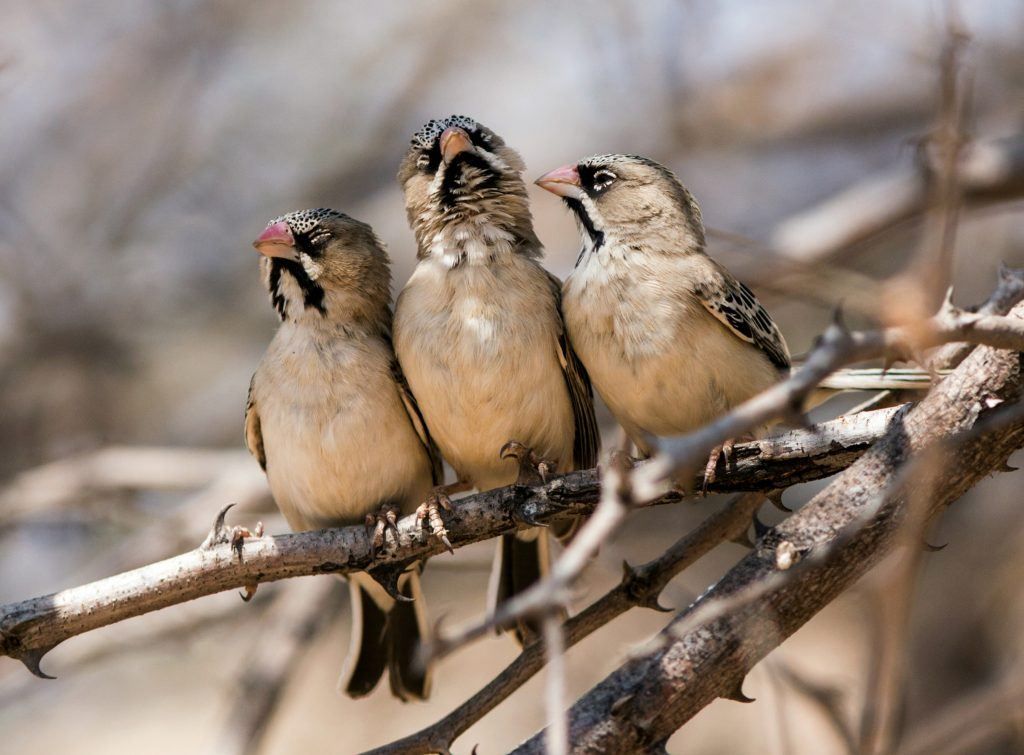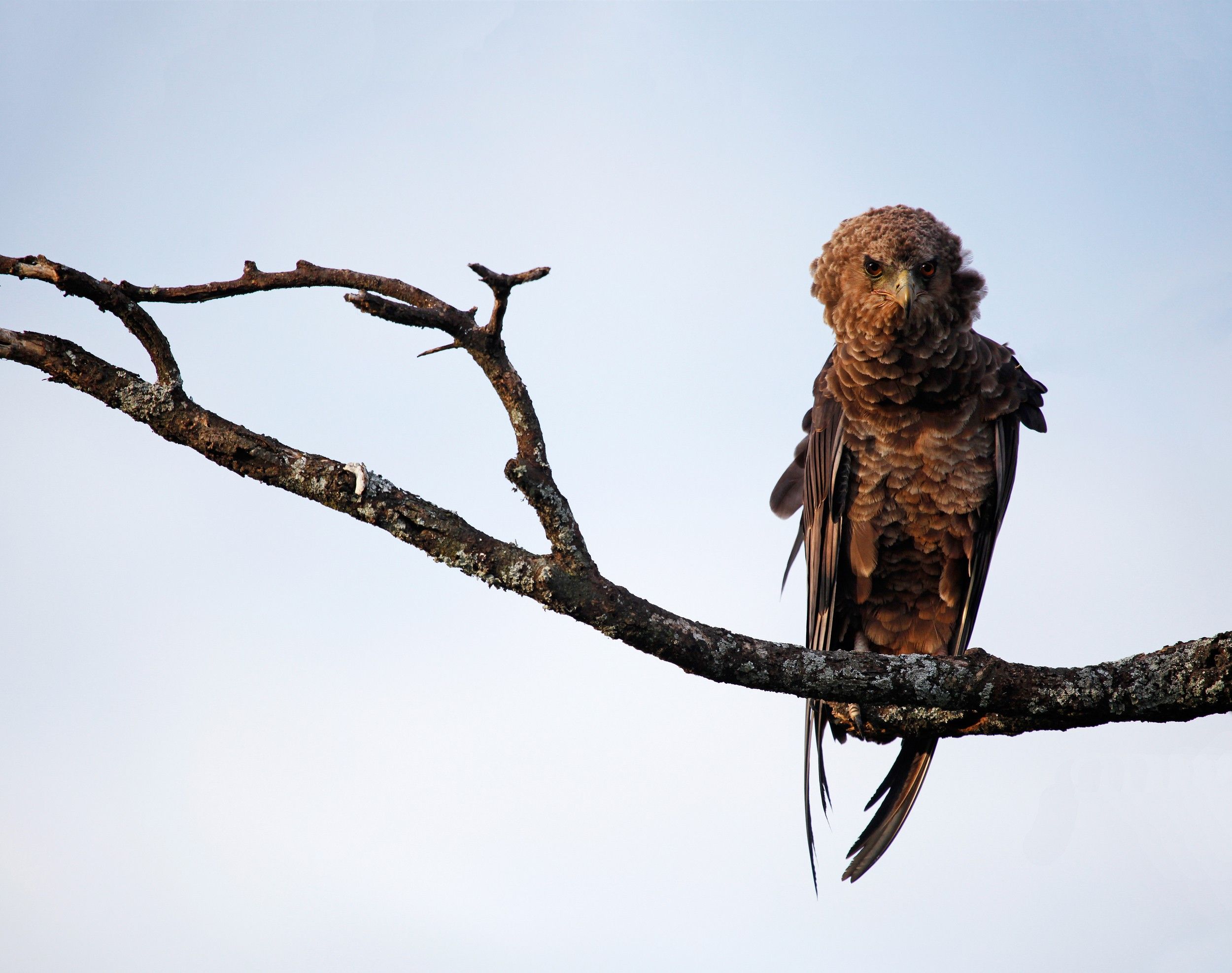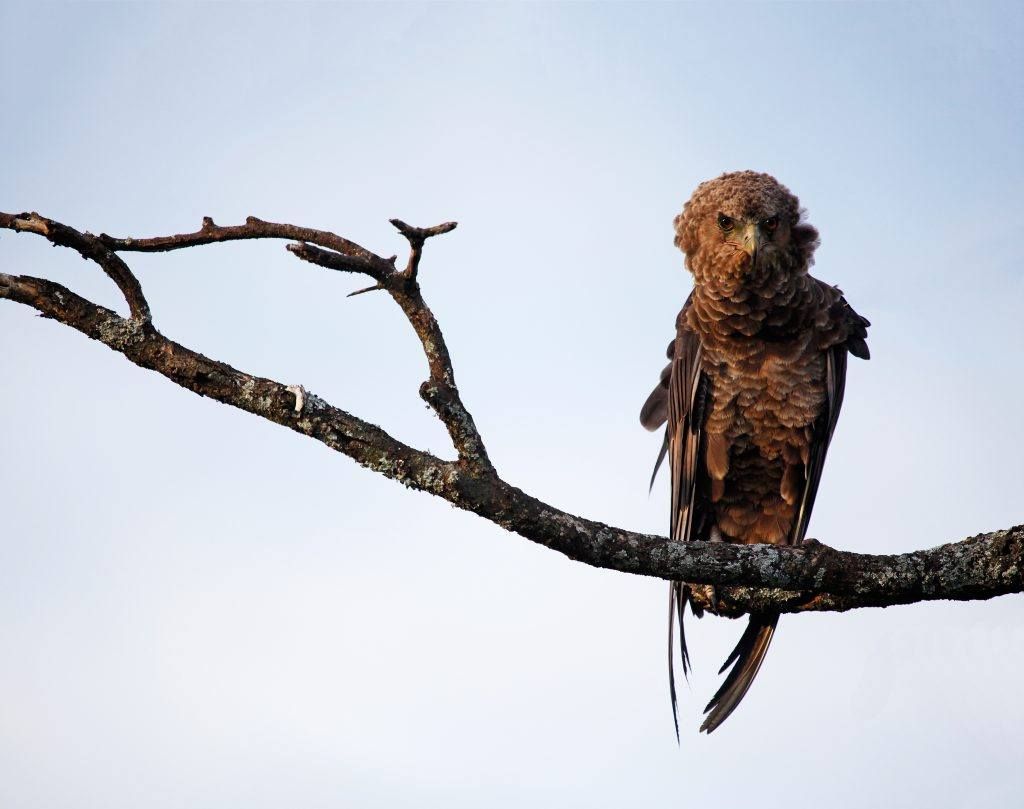Snake-eating eagle, Tanzania, 400mm lens, f5.6 @1/250s, ISO 500. If your passion is photographing wildlife, and in particular birds, you will need a powerful telephoto lens. If the lens is not strong enough to fill the frame with the subject, your only alternative is to crop heavily – but this reduces the pixels in the file, and ultimately the image clarity. Photo by Robin Nichols
When you buy a new DSLR, chances are you will end up purchasing a twin lens kit package. These packages include two lenses along with the camera body, and we buy them because the price offered often looks like a bargain.
Actually, the kit lens combo is a pretty good deal. Who thought a few years ago that you could get a DSLR with a standard lens and a telephoto lens for less than $1,000?
For many (and for those with more photographic experience), a kit lens might appear adequate at best.
One reason for their low cost is that they are constructed (mostly) from plastic.
When it comes to photo gear, you really do get what you pay for.
This is particularly evident with telephoto lenses, because the really good ones are harder and more expensive to manufacture.
The small, go-anywhere 18-55mm zoom kit lens is handy, portable, and produces reasonable results.
The accompanying (kit) telephoto lens is a lot bulkier and generally not very fast (aperture), so it’s harder to get sharp pictures.
Physical size aside, telephoto lenses along with the use of slower shutter speeds can lead to camera shake due to the magnification ratio.
Many years ago, one of the first things I learnt about shooting was a theory called the shutter speed rule.
This rule states that, ‘to avoid camera shake, the shutter speed has to match, or be faster than, the focal length of the lens.’
The focal length of a lens is measured in millimeters. So if you shoot with a standard 50mm lens setting, you need a shutter speed of at least 1/50th of a second to get a camera shake-free result.
If you use a 250mm telephoto lens, it follows that you’d need a minimum shutter speed of 1/250th of a second to get a camera shake-free result.
Of course, this theory only works if you, and your subject, are static.
If this isn’t the case – if the subject is moving or you are moving – then the shutter speed must be faster to cancel out subject motion in possible combination with camera shake.
'To avoid camera shake, the shutter speed has to match, or be faster than, the focal length of the lens.'
Picture yourself sitting in an African safari vehicle.
You spot a lion coming toward your position in the early morning light.
Everyone in the jeep is excited, and they move about trying to get into the best position for a shot.
You extend the 55-250mm telephoto lens that you brought with you to its maximum magnification (i.e. 250mm) to get as tight a shot of the lion as possible.
According to the shutter speed rule, you’d need to use a shutter speed of at least 1/250th of a second to get a sharp result.
It’s at this point in telephoto photography that many photographers get deeper into trouble.
What you will learn in this featured article:
- Why telephoto lenses often produce blurry results
- The importance of maximum aperture
- How the ISO setting can save the day
Recommended Resource: Want a simple way to learn and master photography on the go? Grab our set of 44 printable Snap Cards for reference when you’re out shooting. They cover camera settings, camera techniques, and so much more. Check it out here.
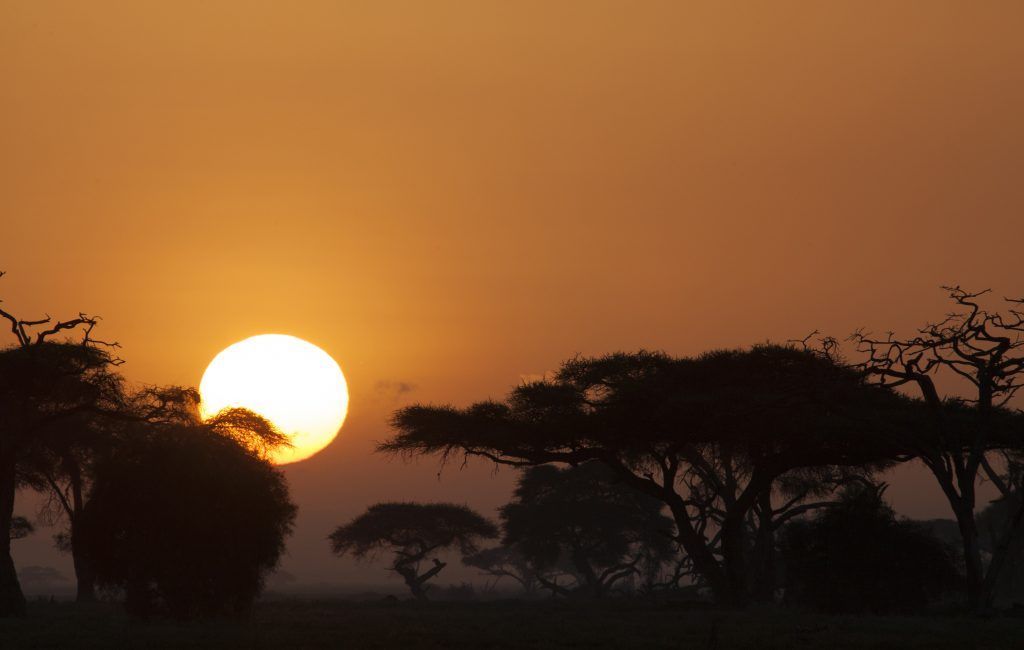
Amboseli National Park, Kenya. Canon 100-400mm lens + 2x Extender, f13 @ 1/640s, ISO500, tripod. Don’t forget that a telephoto lens is a fabulous tool for impressive landscape shots like this sunrise through some acacia trees. I took this using a small aperture to keep the trees relatively clear against the background, and I was able to get a sharp result through my selection of shutter speed and by using a tripod. Photo by Robin Nichols
What's a Telephoto Lens Used for?
- Wildlife
- Landscape
- Portraits
- Sports
- Paparazzi
At 1/250th of a second, and with your image-stabilized lens, you might be lucky to get a sharp picture.
However, the chances are you will need an even faster shutter speed just to make sure – 1/500th of a second would be a better choice. Then, and perhaps only then, will you get a sharp, shake-free result.
But that’s not the end of your shutter speed woes when working with telephoto lenses.

Sossusvlei. Canon 300mm lens + 2x Extender (i.e. 600mm magnification), f9 @ 1/500s, ISO200, tripod. Telephoto lenses are excellent tools for compressing distance and perspective. This large sand dune, in Namibia, was shot from nearly a kilometer away. If I’d walked closer to the base of the dune, I’d have had to use a wide-angle lens to encompass the same details – and even then, the resulting image wouldn’t have been anywhere near as impressive. Photo by Robin Nichols
Most safaris, or any outdoor photo activity (even in your backyard) typically start at dawn or at the Golden Hour. At these times of day, there’s very little light.
So to get that fast 1/500th of a second shutter speed, you’ll need to open up the lens aperture as wide as possible.
With a less expensive telephoto lens, the largest aperture will not be very wide.
If opening up the aperture doesn’t let enough light into the camera to achieve the necessary faster shutter speed, then you’ll have to increase the ISO setting significantly to enable a faster shutter speed.
In practice, this means that using an exposure setting of 1/500th of a second at f5.6 (a common maximum aperture on most low- to medium-priced telephoto lenses), you’ll need an ISO setting of 6400 or higher.
Unfortunately, higher ISO settings in low light will significantly reduce the quality of the resulting image.
Of course, as your photo safari extends into the morning and the light brightens, this will enable you to reduce the ISO setting and therefore get sharp and noise-free results.
Key Lesson: The thing to learn here is that if you are shopping for a telephoto lens, one with a wider than normal maximum aperture will significantly improve your results.
Telephoto Lens Terminology
The higher the focal length number of the lens is in millimeters, the greater the lens magnification, and the physically larger and heavier it’s likely to be.
Some old-school photographers still refer to physically large lenses as ‘long’ lenses, but they should be more correctly termed telephoto lenses.
The higher the focal length number of the lens is in millimeters, the greater the lens magnification, and the physically larger and heavier it’s likely to be.
You can also find very high magnification telephoto lenses. These are referred to as super telephoto lenses.
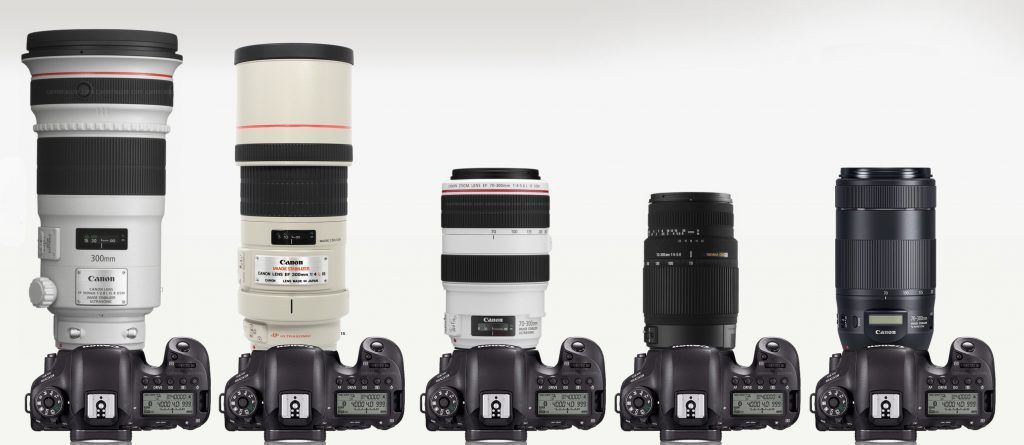
Photo by Robin Nichols
In this side-by-side lens comparison, you can clearly see the physical differences (and therefore the potential handling problems you might encounter) between a super telephoto lens (left) (Canon 500mm f4 lens), a regular telephoto lens (Canon 70-300mm f4-5.6 zoom), a standard 18-55mm zoom lens, and a super wide-angle fisheye zoom lens (right) (Canon 8-14mm zoom). The bigger the lens’ magnification, the harder it is to handhold a lens without the help of a monopod or tripod.
The Crop Factor
Digital cameras come with different-sized sensors, and this produces a different magnification effect with every lens.
It’s not so important to understand why this happens, but it is important to know how much it magnifies the image, because this affects the shutter speed rule.
Full frame cameras use sensors that are the same size as 35mm film, which means a 55-250mm lens has the stated magnification: 55-250mm.
Most consumer DSLRs use smaller APS-C sensors. These provide a magnification factor of 1.5 times.
So, the 55-250mm lens is really a much more magnified 88-375mm telephoto lens.
For many, this is an unseen fact that can easily catch you when you are out shooting in the field.
If you have a Four Thirds camera, it has an even smaller sensor, so the focal length has to be doubled.
Because this format is quite different, you won’t find a Four Thirds lens with a 55-250mm range, but if there were, it’d have a massive magnification ratio of a 110-500mm telephoto zoom lens.
Key Lesson: When practicing the shutter speed rule,” you must take into account the magnification ratio caused by the size of your camera’s image sensor. When dealing with a full frame sensor, the factor is 1:1. When dealing with an APS-C sensor, the factor is 1:1.5. When dealing with a 4/3 sensor, the factor is 1:2.
Recommended Resource: Want a simple way to learn and master photography on the go? Grab our set of 44 printable Snap Cards for reference when you’re out shooting. They cover camera settings, camera techniques, and so much more. Check it out here.
The ISO Setting: What Does It Do, and Why Is It Important When Using Your Telephoto Lens?
ISO is a scale that describes the sensitivity of the camera sensor.
The lowest ISO number is usually the true sensitivity rating, is best used in bright light, and it produces the finest image detail.
When you increase the ISO setting, what you are really doing is increasing the gain, or voltage, inside the camera to magnify hard-to-see detail.
Technically, it’s like over processing film by leaving it in the chemical developer for extended periods of time. It works, but eventually the film develops some nasty side effects.
The lowest ISO number is usually the true sensitivity rating, is best used in bright light, and it produces the finest image detail.
The same holds true with digital.
Most consumer cameras have an ISO range of 100-6400. Some models push this number as high as ISO 12,800, and in some examples even higher than that.
Each time you double the (ISO) number, it essentially allows the camera to choose a shutter speed that’s one exposure step faster.
This can be a real life-saver for most of us, but as the ISO setting climbs higher, picture quality becomes worse, sometimes significantly so.
In some cameras, you won’t see much quality loss up to ISO 1600, but higher values beyond that will begin to look decidedly spotty (or ‘noisy’), sometimes disastrously so, depending on the light, camera make, model, and sensor size.
Key Lesson: High ISO settings used in brighter light will produce significantly better results than higher ISO settings exposed in low light. With the latter, you might get a sharper result (due to the higher shutter speed), but the image quality might be disastrously noisy and show poor color.
The larger the image sensor, the better (cleaner) its higher ISO noise characteristics will be.
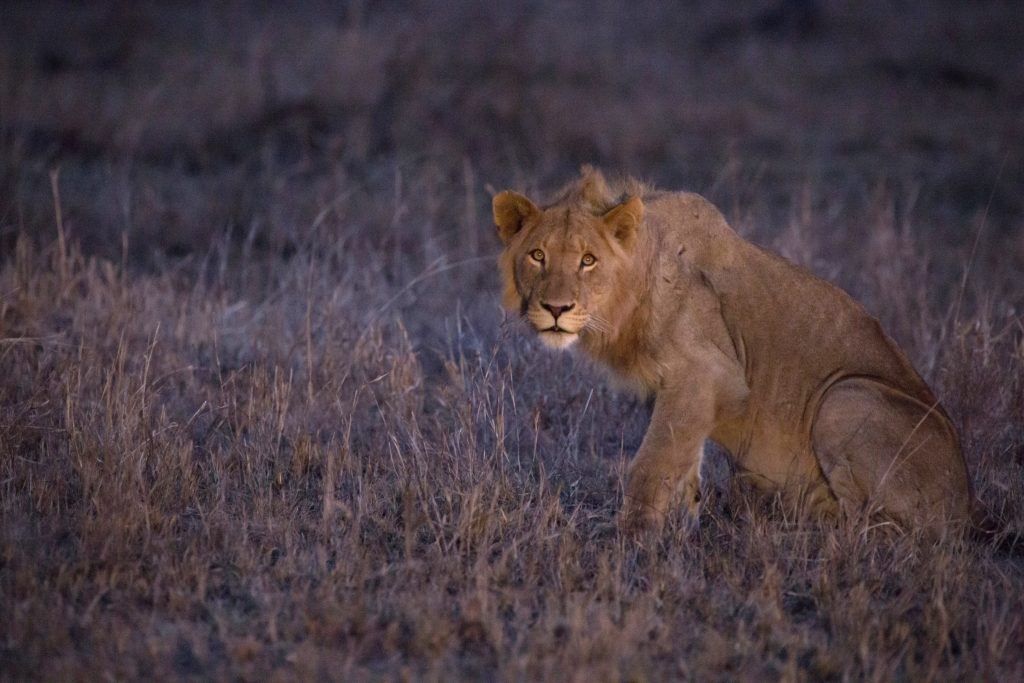
It was almost dark when I shot this picture of a lion in the African scrub. The color is not good, because I had to increase the ISO setting to 12,800, making it very noisy and oddly colored. Photo by Robin Nichols
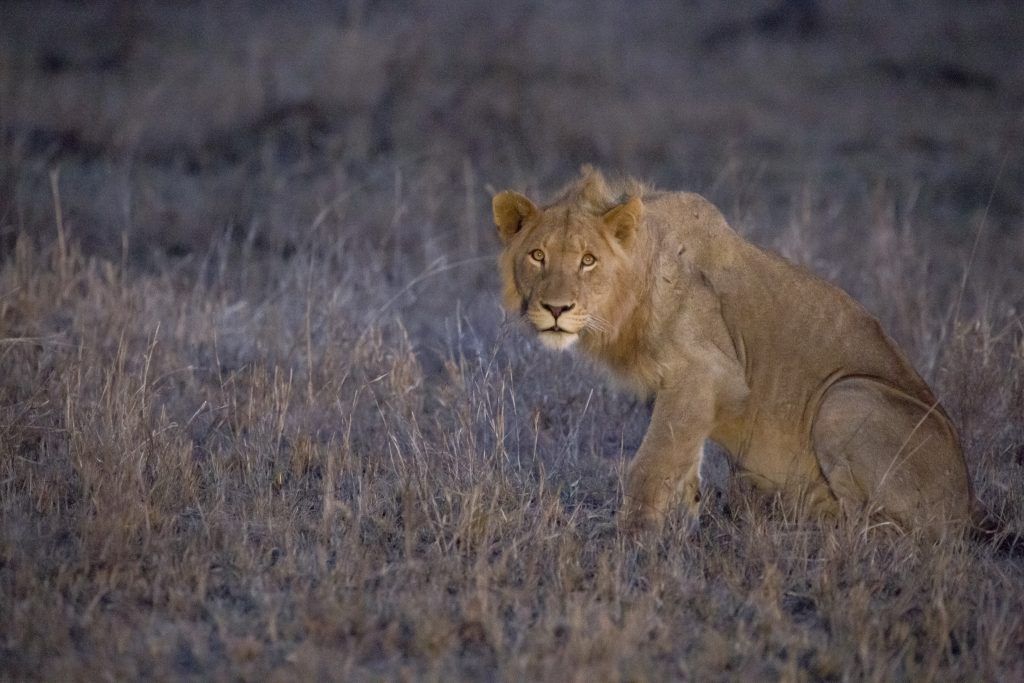
This image has been color corrected, and I had some of the noise removed using Adobe Camera RAW. Amazingly this came out reasonably sharp, despite the 1/40th of a second shutter speed. I used a monopod, and I asked everyone in the vehicle to be still for a moment. In this case, it worked! With experience, you can shoot with a telephoto lens at lower shutter speeds. However, it takes practice. Photo by Robin Nichols
Here’s a problem faced by many wildlife photographers using telephoto lenses: “heat haze.” We were not allowed any nearer to the shore of Lake Manyara, and even then it was already very hot, so irrespective of the shutter speed, aperture, or ISO setting that was used, every picture was fuzzy – caused by the heat rising off the land in the foreground. We came back very early the next day and it was much better, but by then the flamingoes were on the other side of the lake!
Key Lesson: When using very long telephoto lenses, the time of day can become an important factor. This consideration is not only for exposure settings, but also because of an optical phenomenon called heat haze.
It’s not all bad news.
Spending more money can solve most shutter speed problems.
The biggest limitation of cheap telephoto lenses is their poor, and variable, maximum apertures.
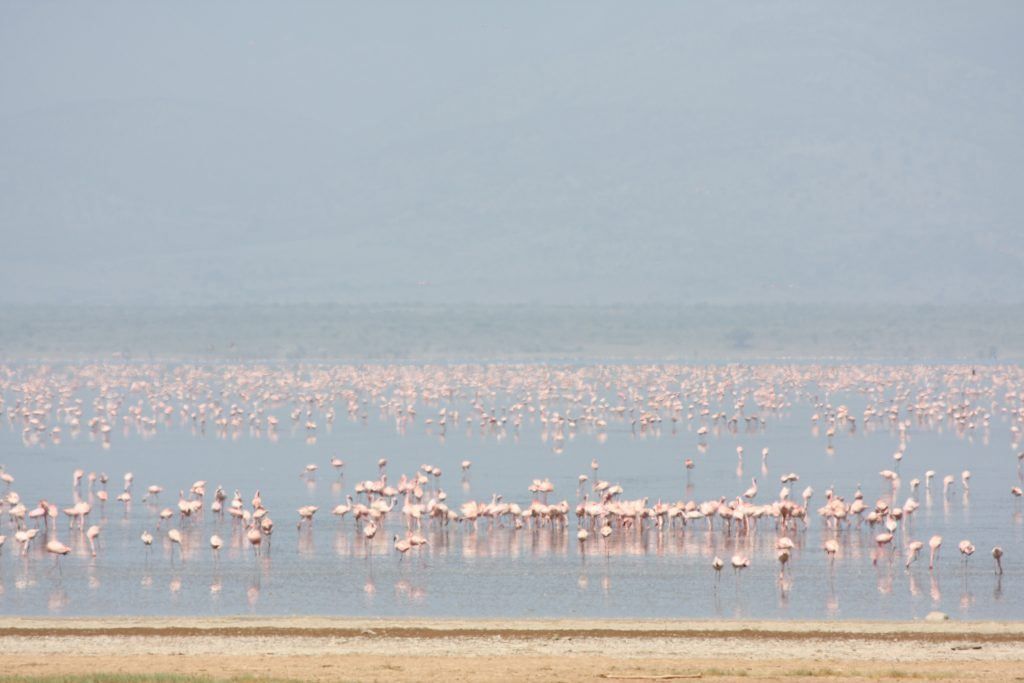
Photo by Robin Nichols
In all of those dim lighting situations, like a dawn safari, the lens simply just can’t be opened wide enough to let in sufficient light for a faster shutter speed.
Those big white lenses seen at sporting events actually don’t magnify much more than the kit lens described earlier in this article
But apart from being robustly constructed, and incorporating the best quality optical glass elements, they also have a much wider fixed maximum aperture.
This allows two or three more exposure steps of light into the camera than those cheaper products.
High quality professional telephoto lenses are made to last, and they usually incorporate specialist ultralow dispersion, or aspherical glass elements in their construction.
This special glass produces significantly sharper results, with less optical distortion, and because of their wider maximum apertures they produce faster shutter speeds in poor lighting.
However, these pro lenses can be insanely expensive.
High quality professional telephoto lenses are made to last, and they usually incorporate specialist ultralow dispersion, or aspherical glass elements in their construction.
Luckily, for semi-professional photographers, there are many less expensive zooming and non-zooming telephoto lenses on the market.
Most of the affordable models of telephoto lenses are made by third-party specialists, like Sigma and Tamron.
It’s important to note that because it’s cheaper to manufacture a non-zooming lens, they are typically more affordable than zoom lenses. Plus, they’ll likely have a wider maximum aperture.
As an example, a Canon EF 300mm f4 L series lens costs about $1,900 – cheap in comparison to its wider aperture f2.8 sibling, which will cost closer to $8,000.
Canon also sell an excellent 70-300mm f4 5.6 zoom L-series lens for about $1,800. However, it is quite expensive, bulky, and heavy; but, like the f4 version, this lens incorporates the best glass possible.
On a more practical note, there’s also a consumer level 70-300mm f4-5.6 lens costing about $600.
Again, not the best maximum aperture or quality of glass, but at slightly twice the price of the 55-250mm kit lens it will give you excellent results.
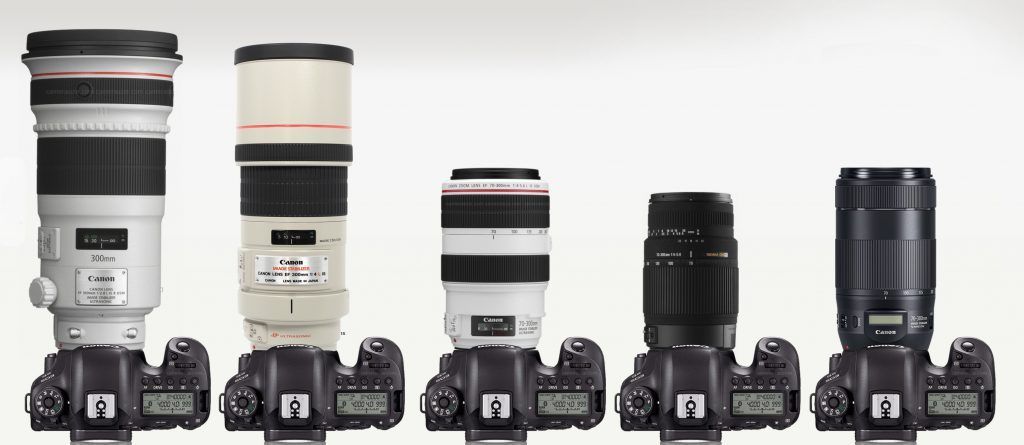
Many folks will baulk at paying anything more than a few hundred dollars for a telephoto lens, especially if it’s just for a one-off trip. But don’t forget that lenses like this can also be effectively used for landscapes and portraits. Thankfully, there are plenty of less expensive but quality-driven options open to the amateur market, like Canon’s f4 300mm lens (second from left) and its 70-300mm L series zoom (center). Sigma also offer an excellent 70-300mm telephoto alongside Canon’s main consumer lens with similar specifications (far right). Photo by Robin Nichols
Using Extenders
If you have a fast aperture f4 or f2.8 telephoto lens, it’s possible to increase its magnification by a factor of 1.4 times, or two times, by adding an extender.
An extender is an optical magnifier that fits between the lens and the camera body.
Adding one of these reduces the light entering the camera by one and two f-stops respectively.
However, it’s still a significantly cheaper way to increase the power of your telephoto lens over buying a new lens with double the magnification!
Adding a 1.4x Extender to the EF 300mm f4 L series lens will convert it into a 425mm f5.6 lens.
You might lose a little sharpness, but I think this is an acceptable loss with all things considered.
Recommended Resource: Want a simple way to learn and master photography on the go? Grab our set of 44 printable Snap Cards for reference when you’re out shooting. They cover camera settings, camera techniques, and so much more. Check it out here.
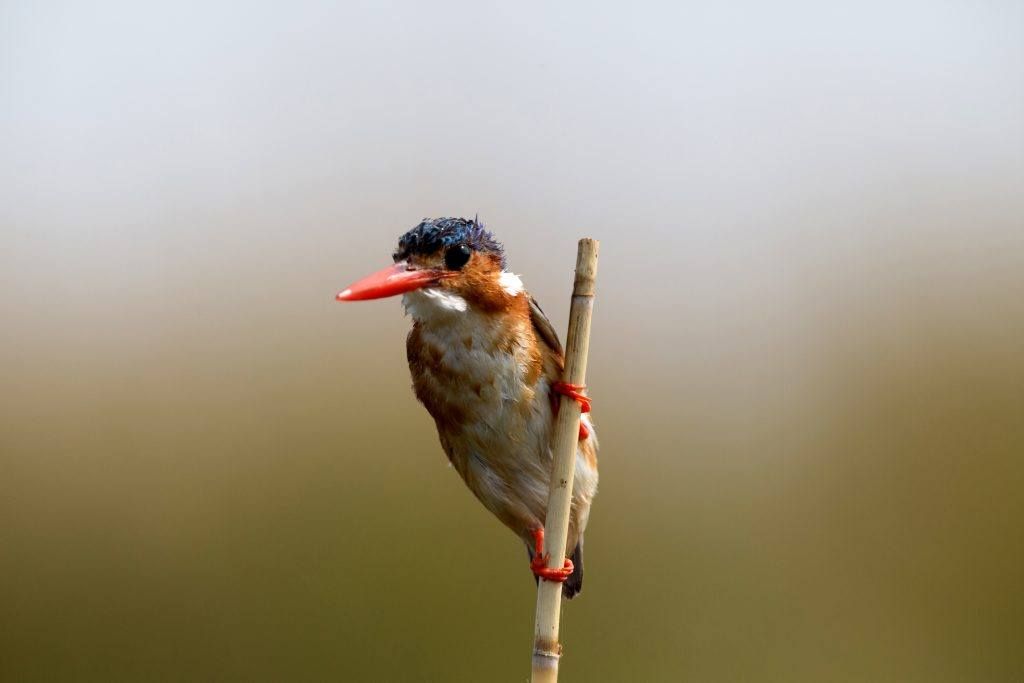
This image is one of my favorite bird photos. This tiny malachite kingfisher was snapped from a tinnie while drifting through the reeds along the banks of the Chobe River in Botswana. Canon 300mm lens + 2x Extender (the new focal length became 600mm), in good light, gave me a shutter speed of 1/1250s, at f9 with ISO 640. Photo by Robin Nichols
In Summary
A wide maximum aperture (on any lens, but especially telephoto lenses) will allow you to shoot with a faster shutter speed, which in turn produces significantly sharper-looking results.
If you can’t afford anything more than an entry-level, or a consumer mid-priced telephoto lens (with smaller maximum apertures), you can compensate by raising the ISO setting to increase the shutter speed, as per the shutter speed rule.
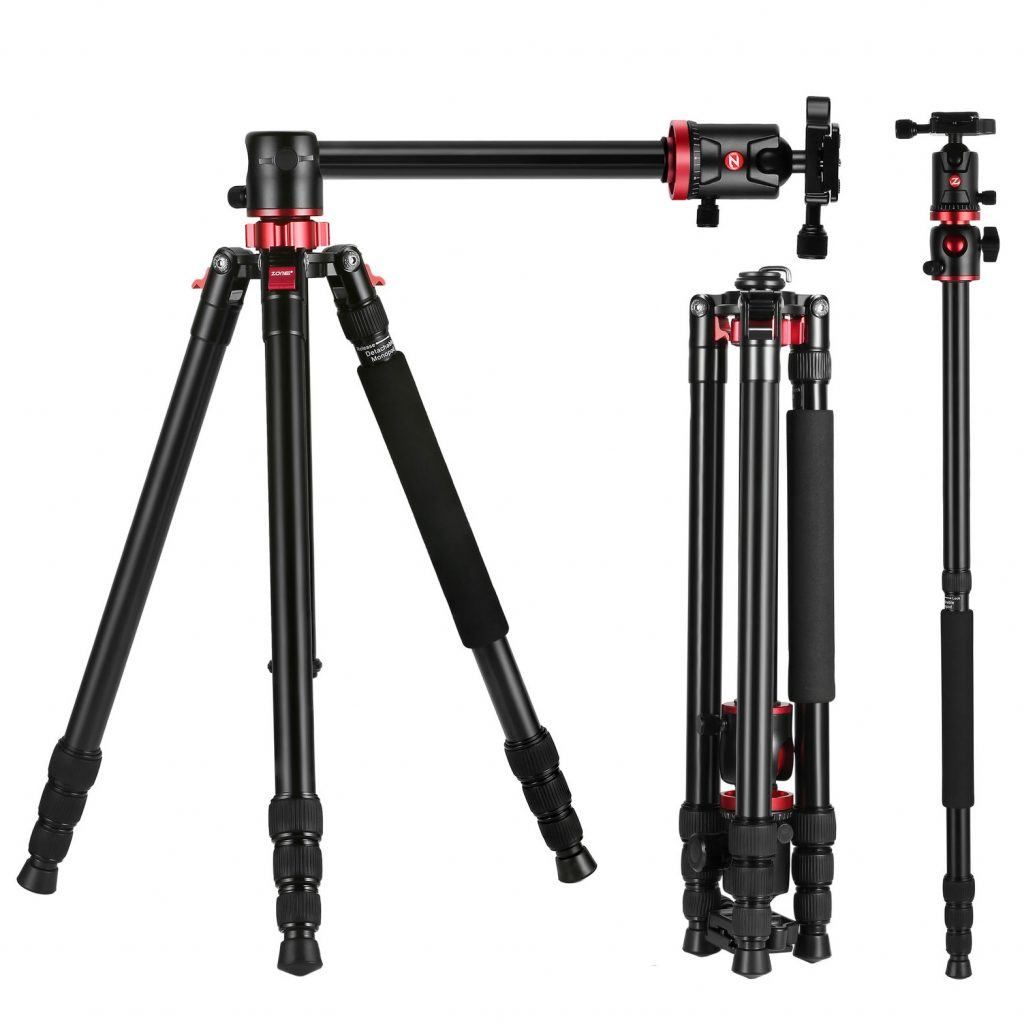
Besides adhering to the shutter speed rule, one of the best ways to ensure your big magnification telephoto shots will remain pin sharp is to support the camera and the lens with a tripod or a monopod. Many brands do both – it’s a tripod, but unscrew one of the legs and it becomes a very functional monopod. This is a must-have for the telephoto lens photographer! Photo by Robin Nichols
One of the best (and the cheapest) ways to get sharper shots with big magnification telephoto lenses is to use a tripod.
If you are in a vehicle, you could try a monopod or a sandbag. These simple accessories can bring an additional two shutter speed steps of sharpness to your work without having to push the ISO setting too high for comfort.
